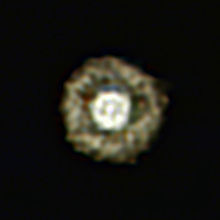Yellow hypergiant
The yellow hypergiants are stars with absolute brightnesses of M V = −8 and effective temperatures of 4000 to 8000 K. This corresponds to a spectral class from late A to early K and luminosity class 0 or Ia. The yellow hypergiants are very rare with only a dozen or so known stars in the Milky Way . The radii of the visible photosphere are a few hundred solar radii. The yellow hypergiants are also called warm hypergiants in English .
properties

Yellow hypergiants show signs of strong mass losses through stellar winds , whereby the mass losses are episodic and can reach up to 0.05 solar masses per year. Pronounced infrared excesses are observed through cool circumstellar material, which has flowed off the star and now absorbs the radiation and emits it again at low temperatures of 100 K. The strength of the stellar winds can often be determined using P-Cygni profiles , with wind speeds of a few hundred kilometers per second being found. The stars show strong fluctuations in their surface temperatures due to the formation of pseudophotospheres. The outflowing gas near the atmosphere is so dense that the actual surface of the star is not accessible to the observer and only light re-emitted in the pseudophotosphere can be analyzed.
variability
Yellow hypergiants lie within the instability strip and therefore belong to the pulsation-variable stars with a semi-regular nature . The amplitude is usually low with amplitudes of up to 0.3 mag and pulsation periods of 300 to 1000 days. In addition, there is an irregular change of light as a result of the heavy mass losses at times. The repelled material reabsorbs the radiation from the star and re-emits it at low temperatures. Rho Cassiopeiae sometimes shows the spectrum of a red hypergiant with a spectral type M. The visual brightness drops sharply during these periods because a large part of the radiation is emitted in the infrared range. These envelope episodes are likely caused by the formation of negative density gradients in the outer atmosphere of the yellow supergiants. In combination with a very low gravitational acceleration in the photosphere, vibrations can lead to the shedding of parts of the atmosphere. The pulsations in the star's atmosphere are the cause of the uniform loss of mass due to stellar winds, as they accelerate matter beyond its escape speed due to the large expansion .
development
In the Hertzsprung-Russell diagram , the area of the yellow hypergiant is practically empty and the area is therefore called the yellow development gap. The developmental state of the yellow supergiants is interpreted differently.
- Either the yellow hypergiants had masses of around 25 to 40 solar masses during their time on the main sequence . According to these sources, the yellow hypergiants are moving towards lower temperatures. The stars that evolve towards higher temperatures are probably unstable and are therefore not observed. The duration of stay in the area of the yellow hypergiant is astronomically very short with a duration of about 10,000 years. According to simulation calculations, these stars are in the state of contraction of the helium nucleus before a central helium burn has ignited.
- Others describe yellow hypergiants as successors to the red supergiants with original masses of more than 40 solar masses on the way to higher temperatures in the HR diagram. According to this, the yellow supergiants are only in a short transition stage between the red supergiants on the way to the luminous blue variables or to the Wolf-Rayet stars , which subsequently find their end in a supernova explosion .
Yellow hypergiants were identified in type IIb supernovae SN 1993J and SN 2011dh on recordings before the explosion at the location of the supernova and could no longer be detected a few years after the eruption. Some yellow hypergiant seem to develop very quickly with a temperature increase of 1000 ° C within 10 years at IRC + 10420 .
Examples
Individual evidence
- ↑ Roberta M. Humphreys, Kris Davidson, Skyler Grammer, Nathan Kneeland, John C. Martin, Kerstin Weis, Birgitta Burggraf: Luminous and Variable Stars in M31 and M33. I. The Warm Hypergiants and Post-Red Supergiant Evolution . In: Astrophysics. Solar and Stellar Astrophysics . 2013, arxiv : 1305.6051v1 .
- ^ H. Nieuwenhuijzen, C. De Jager, I. Kolka, G. Israelian, A. Lobel, E. Zsoldos, A. Maeder, and G. Meynet: The hypergiant HR 8752 evolving through the yellow evolutionary void . In: Astronomy & Astrophysics . tape 546 , 2012, p. A105 , doi : 10.1051 / 0004-6361 / 201117166 .
- ↑ VGKlochkova, VEPanchuk, NSTavolganskaya, IAUsenko: Instability of the kinematic state in the atmosphere of the hypergiant Rho Cas outside outburst . In: Astrophysics. Solar and Stellar Astrophysics . 2013, arxiv : 1312.6922v1 .
- ↑ JR Percy: Understanding Variable Stars . Cambridge University Press, Cambridge 2007, ISBN 978-0-521-23253-1 .
- ↑ Yuri A. Fadeyev: Pulsational instability of yellow hyper giants . In: Astrophysics. Solar and Stellar Astrophysics . 2011, arxiv : 1102.3810 .
- ↑ Dinh-V-Trung, Sebastien Muller, Jeremy Lim, Sun Kwok, C. Muthu: Probing the mass loss history of the yellow hypergiant IRC + 10420 . In: Astrophysics. Solar and Stellar Astrophysics . 2009, arxiv : 0903.3714 .
- ↑ Rene D. Oudmaijer, Ben Davies, Willem-Jan de Wit, Mitesh Patel: Post-Super Red Giants . In: Astrophysics. Solar and Stellar Astrophysics . 2008, arxiv : 0801.2315 .
- ^ M. Ergon et al .: Optical and near-infrared observations of SN 2011dh - The first 100 days . In: Astrophysics. Solar and Stellar Astrophysics . 2013, arxiv : 1305.1851v1 .
- ^ M. De Becker, D. Hutsemékers, E. Gosset: The XMM-Newton view of the yellow hypergiant IRC +10420 and its surroundings . In: Astrophysics. Solar and Stellar Astrophysics . 2014, arxiv : 1401.0707v1 .